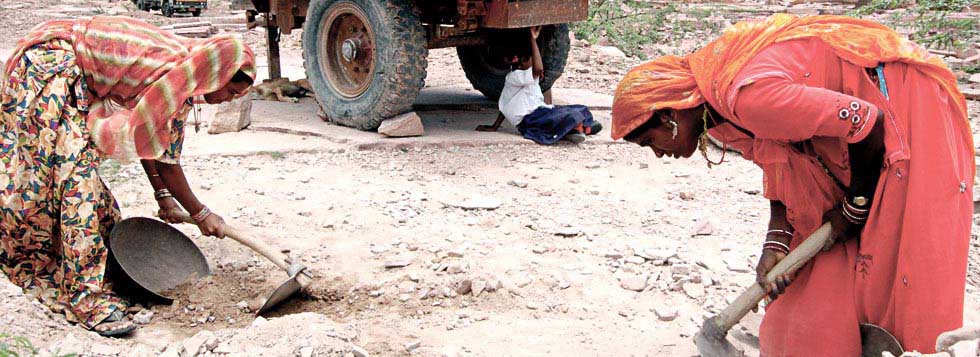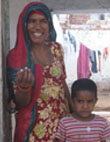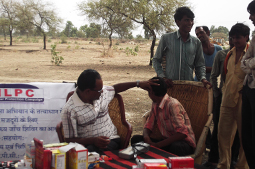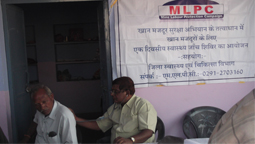
Occupational Health and Safety
MLPC started to focus and organize mine workers on Occupational Health from 2009 onwards, after the death of Padma at the age of 40. Padma, a tribal mineworker used to work in the Asbestos mines for 15 years in Udaipur district of Rajasthan. He was associated with MLPC and underwent training on Occupational Health and Safety in Ahmedabad in 2008. The death of Padma after just 3 months of attending the training in February 2009 was a turning point for MLPC. Inquiry into his death revealed, only as a suspect though, that asbestosis could have been the cause. MLPC immediately organized a medical diagnostic camp for the mine and quarry workers for the first time in the state and 3 cases of asbestosis were diagnosed. Poor working conditions in the stone quarries of Rajasthan lead to severe occupational health hazards and diseases. Dangerous diseases like silicosis and tuberculosis are widespread among the mine and quarry workers of Rajasthan.
Working for the occupational rights of these communities is a challenge because the workers often are unaware that they are suffering from an occupational disease; and the rural areas where they live make it very difficult for outreach and timely medical care. Most of the workers do not have any access to healthcare. Nor do they have any medical insurance provided by the state, or through their employers, or undergo any medical check ups until their health situation is dire. Even when they do, the affected mineworkers do not get proper treatment as the local doctors are not specialized or familiar with occupational health diseases such as silicosis and asbestosis. MLPC is advocating to bring health care services to the mine workers, like regular free health check ups, linking patients to the government provisions for free health care. It is also working to reduce occupational health hazards by stipulating safeguards like a mask to the worker, providing for toilets in the workplace, clean drinking water and health insurance.
Silicosis Strikes

Raju Devi was born into a family of mine workers in Jodhpur in the year 1975. Her father and 2 brothers worked in the mine, while she and her 4 sisters stayed at home along with their mother. Raju Devi was married off when she was 3 months old and she moved in with her husband when she was 15 years. It so happened that Govardhan, her husband had been working as a daily wage mine labourer since he was 10 years old. His other family members too worked in the mines. 7 years ago, Govardhan died, leaving behind a son, Shravan who is now 17 years; a daughter, Kanchan who is now 14 years; a son, Jeetu who is now 12 years and the youngest son, Kishen who is now 7 years. Govardhan had vomited blood one day and started treatment. A fortnight later he had fever and cough along with vomiting blood. He was rushed to the hospital where after 2 days he expired. It was then diagnosed that Govardhan had been suffering from silicosis. Neither he nor the doctors treating him at the local health centre had any knowledge of the disease. As fate would have it and the vicious cycle of poverty, the burden of taking care of the family fell on the eldest son, Shravan, who was then 10 years old. He became a mine worker for the upkeep of his mother and young siblings since that tender age. Even today he works in the mines. When Kishen, the youngest son was 6 months old (3 months after his father passed away), Raju Devi learnt that he too had silicosis. Kishen stays at home with his mother, while his sister and brother goes to school. For 2 years after her husband passed away, Raju Devi remained a home maker and took care of Kishen. However, her husband had been in debt and she had financial liabilities to cope with, apart from social and emotional loss. For a year she too worked in the mines. Having never worked in a mine, she could not keep up with the hard work and left after a year. Her natal family and her husband’s elder brother took care of her and the children, in the interim. She learnt about the work of MLPC only 2 years ago through Suji Devi, her neighbour. For a year and a half she worked tirelessly as a volunteer with MLPC since she was inspired by the work. It was only 6 months ago that she joined MLPC as a staff in-charge of a crèche. Today she is part of the core committee that works with silicosis victims. She handles the monthly camps (held twice every month) and is responsible for enrolling family members and widows for government schemes. Along with Suji Devi she too leads organized protests and engages in dialogue with government officials. As a widow of silicosis victim she did receive INR 1 lakh. Part of that money was used to pay off the debts of her late husband; she gave INR 50,000 as a loan (charging 2% interest) to her husband’s elder brother (she receives INR 1000 every month); she bought 2 life insurances for herself and her older son; and she donated INR 5000 to the Union, of which she is a member. At a personal level, she is constantly worried about the health of Kishen. She is also fighting social odds to keep Kanchan in school. As is the trend in Rajasthan, her family, friends are pressurizing her to marry off her 14 year old daughter, who aspires to become a Policewoman. Raju Devi wants to help Kanchan fulfill her aspiration. Shravan continues to work in the mines since with spiraling expenses it is difficult to manage the family on a single income.


